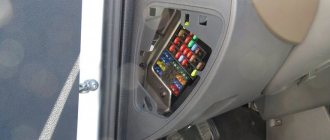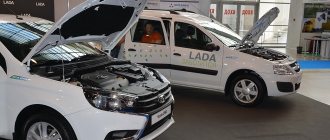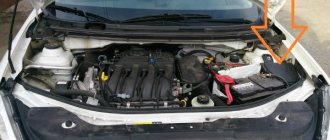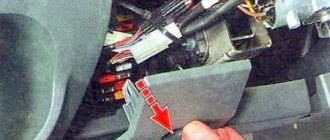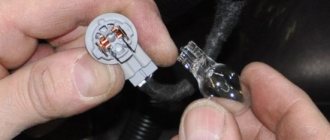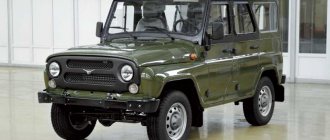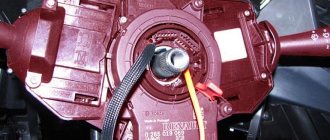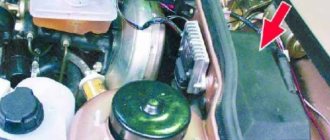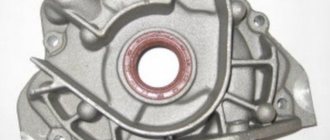Location of the main components and assemblies of the Lada Vesta
The design of the Lada Vesta car is very different from previous Lada models.
A new engine has been installed in the engine compartment, the location of the main components has been changed, and a new front suspension and rear beam are used. There are also differences in the brake and other systems of the car. Let's look at the features of Vesta's device in detail. The power unit is mounted on two rubber-metal supports (pillows) mounted on the front side members of the body. To reduce vibrations of the engine, together with the gearbox, a rear support is additionally installed below, which is attached to the transverse beam of the front subframe.
The front suspension arms and front anti-roll bar are also attached to the subframe. The steering mechanism (rack) is mounted on the front subframe, which reliably protects it from possible impacts on road irregularities, but makes it difficult to access in case of repairs.
The rear suspension beam of the car is attached directly to the body brackets on two rubber-metal hinges. Springs and shock absorbers are installed separately. See suspension device.
Engine compartment of a Lada Vesta: 1 — hood stop; 2 — windshield washer reservoir; 3 — ignition coils; 4 — reservoir of the main brake cylinder; 5 — engine air filter; 6 — fuse and relay block; 7 - battery; 8 — resonator (muffler of the air intake system); 9 — engine oil filler cap; 10 — oil level indicator in the engine crankcase (dipstick); 11 — intake pipe receiver; 12 — right engine mount; 13 — expansion tank of the engine cooling system.
Bottom view of Lada Vesta, front part: 1 - front brake mechanism; 2 — front subframe; 3 — auxiliary drive belt; 4 - generator; 5 — air conditioning compressor; 6 - starter; 7 — electric fan of the cooling system; 8 — electric clutch release (for AMT); 9 — front suspension arm; 10 — front wheel drive (left); 11 — gearbox; 12 — rear support of the power unit; 13 — steering mechanism (rack); 14 — catalytic converter; 15 — front wheel drive (right); 16 — engine crankcase oil pan; 17 — front suspension strut.
See also the exhaust system (muffler) design. Let us remind you that on our website you can find reviews about the new Vesta VAZ-21129 engine, the French JH5/JH3 gearbox, as well as the AMT from VAZ.
Block in the cabin
It is located under the instrument panel, on the driver's side behind the protective cover.
In order to remove it, you need to get plastic nails by prying them up with a flat screwdriver or a special device. There is no need to twist them. Then simply pull the lid towards you.
Photo - example
Scheme
Description of fuses
Option 1
| F1 | 15A Windshield washer |
| F2 | 5/30A Steering column switch for exterior lighting and turn indicators |
| F3 | 10A Left headlight high beam lamp |
| F4 | 5/30A Steering column switch for exterior lighting and turn indicators |
| F5 | 15A Heated seats |
| F6 | 5A Side lights of the right block headlight and right rear lamp |
| F7 | 5A Side lights of the left block headlight and left rear light |
| F8 | 5A Rear fog lamp |
| F9 | 3A Side right turn signal |
| F10 | 5A Robotic gearbox selector |
| F11 | 10A Low beam lamp for left headlight |
| F12 | 15A Direction indicators |
| F13 | 10A Body electrical control unit |
| F14 | 10A Brake light switch |
| F15 | 5A Rain sensor, light sensor, electric headlight corrector |
| F16 | 5A Brake light switch |
| F17 | 5A Glove box lamp, trunk lamp, threshold lamps |
| F18 | 3A Left side turn signal |
| F19 | 10A Low beam lamp, right headlight |
| F20 | 5A Heated exterior mirrors |
| F21 | 15A Passive safety system SRS (airbags) |
| F22 | 5A Instrument cluster |
| F23 | 5A Instrument cluster |
| F24 | 5A "ERA GLONASS", audio system |
| F25 | 5A Stability control system ESP |
| F26 | 15A Fuel pump |
| F27 | 5A Parking assistance system |
| F28 | 5A Electric power steering |
| F29 | 5A Connector for connecting trailer lighting equipment |
| F30 | 5A "ERA GLONASS" |
| F31 | 5A "ERA GLONASS" |
| F32 | 10A Robotic gearbox, reverse light switch, heated windshield |
| F33 | 5A Electric windows |
| F34 | 5A Steering angle sensor, cruise control and multimedia system control switches on the steering wheel |
| F35 | 5A Switch block for controlling electric windows and electric rear-view mirrors |
| F36 | 15A Audio system, diagnostic connector |
| F37 | 7.5A Brake light lamp, right rear light |
| F38 | 7.5A Left rear brake light lamp |
| F39 | 10A Daytime running lights |
| F40 | 10A Left headlight high beam lamp |
| F41 | 20A Electrical socket, cigarette lighter |
| F42 | 20A Body electrical control unit |
| F43 | 20A Electric door locks |
| F44 | 30A Electric windows |
| F45 | 30A Electric heater fan |
| F46 | 30A Wiper |
| F47 | 25A High beam lamp of the right headlight unit, low beam lamp of the left unit - headlights, side lights of the left unit - headlights and left rear light |
| F48 | 30A Wiper |
| F49 | 25A Fog lights, rear fog light, license plate lights |
| F50 | 25A High beam lamp of the left headlight unit, low beam lamp of the right unit - headlights, side lights of the right unit - headlights and right rear lamp |
| F51 | 5A Clutch pedal position sensor |
The cigarette lighter is controlled by fuse number 41 at 20A.
Option 2
| F1 | 5A Power supply for 1 terminal device (TD) of the “Emergency response in case of accidents based on the Global Navigation Satellite System” (ERA-GLONASS) system |
| F2 | 5A Power supply for 1 instrument cluster (KP) |
| FZ | 10A Terminal K15 circuit for engine compartment |
| F4 | 10A Right low beam headlight circuit (FBS) |
| F5 | 10A Left low beam headlight circuit (FBS) |
| F6 | 5A Signal K15 for electric power steering (EPS) |
| F7 | 15A Power supply for the airbag system controller (SNPB) |
| F8 | 5A Power supply for parking assistance system (parking sensors) |
| F9 | 5A Right side turn signal circuit. mirrors |
| F10 | 3A Rear fog light circuit (RFL) |
| F11 | 3A Turn signal circuit (TU) left side. mirrors |
| F12 | 10A Daytime running lights (DRL) circuit |
| F13 | 10A Right high beam headlight circuit (FDS) |
| F14 | 10A Left high beam headlight circuit (FDS) |
| F15 | 5A Exterior mirror heating circuit |
| F16 | 5A Accessory power bus (ACC position of the ignition switch) Radio/multimedia, TU ERA-GLONASS |
| F17 | 5A Chain of rear side lights (ZdGO) |
| F18 | 7.5A Circuit of front side lights (PrGO) |
| F19 | 7.5A Left brake light circuit |
| F20 | 7.5A Right brake light circuit |
| F21 | 15A Power supply for body electronics unit (BEM), turn signal circuit |
| F22 | 5A Power supply for 2 ERA-GLONASS terminal devices |
| F23 | 5A Power supply 2 instrument clusters (KP) |
| F24 | 5A Automated manual transmission (AMT) selector power supply |
| F25 | 5A Bus for switching on the current response (VTR) for the block of additional functions of body electronics (BDFKE) and the drive of the side mirrors |
| F26 | 5A VTR bus for interior and trunk lighting |
| F27 | 5A BTR bus for brake switch circuit |
| F28 | 15A Power supply for radio and diagnostic connector |
| F29 | 10A Power supply for trailer lighting |
| F30 | 15A Fuel pump power supply |
| F31 | 5A VTR bus for controlling the power window and interior heater relays |
| F32 | 5A VTR bus for headlight range control switch and rain and light sensor (RDiO) |
| F33 | 5A Bus VTR for steering angle sensor |
| F34 | 5A VTR bus for AVZ/E8R controller |
| F35 | 5/25A Power supply for 1 left steering column switch for luxury/non-luxury trim levels (FDS, GO) |
| F36 | 10A Power supply for brake light |
| F37 | 10A Power supply for body electronics unit (BEM) |
| F38 | 5/25A Power supply 2 left steering column switches for luxury, norm, standard (FBS, DRL) |
| F39 | 20A Power supply for the right steering column switch (window cleaning, washing) |
| F40 | 15/30A Power supply for the additional body electronics functions unit (BDFCE)/heated front seats (for standard, normal) |
| F41 | 20A Power supply for accessories (ACC position of the ignition switch), cigarette lighter |
| F42 | 20A Body electronics unit (ВСМ, BTR bus power supply) |
| F43 | 20A Body electronics unit (ВСМ, power supply for door locks) |
| F44 | 30A Power windows |
| F45 | 30A Power supply for interior heater fan |
| F46 | 30A Front wiper power supply (standard, normal) |
| F47 | 25A Power supply for additional body electronics unit (EMM) circuits: right DS, left BS, front HO, right DRL |
| F48 | 30A Power supply for optional body electronics module (EMM) circuit: front wiper |
| F49 | 25A Power supply for the additional body electronics unit (EMM) circuits: fog lights (PTF), rear fog lights (RFL), license plate lights (LPL) |
| F50 | 25A Power supply for additional body electronics unit (EMM) circuits: left DO, right EC, rear HO, left DRL |
| F51 | 15A Power supply for PTF relay (ZM, normal) |
| F52 | 5A Charger Power |
| F53 | 5A Power supply for cruise control buttons on the steering wheel |
| F54 | Reserve |
| F55 | 15A Power supply for 12V socket in trunk |
Fuse number 41 for 20A is responsible for the operation of the front cigarette lighter, and fuse number 55 for 15A is responsible for the socket in the trunk.
Relay purpose
| K1 | Power supply for lighting and seat heating |
| K2 | Free |
| K3 | Heated rear window |
| K4 | Front windows |
| K5 | Interior heater fan |
| K6 | Rear window lifter |
| K7 | Fuel pump module |
| K8 | ACC (12V socket power supply) |
| K9 | Power supply for fog lights |
Four years with Lada Vesta - the most detailed and honest report
No other foreign car in its class offers such diversity.
LADA > Vesta
Lada Vesta, having entered the market at the end of 2015, quickly gained momentum and in 2018 turned out to be the sales leader in Russia. Now, in a falling market, it has only let its more affordable relative, Grant, pass ahead, while it continues to grow with new versions.
No other foreign car in its class offers such diversity: a sedan, a station wagon, two pseudo-crossovers based on them, sports and methane modifications, three power plants and more than 20 equipment options.
Work progress
The installation process is quite simple. First you need to fix the LED strip or module on the back of the hood. To do this, you can use plastic clamps, copper wire, 2-sided tape, etc. As the experience of the owners shows, plastic clamps are the best option.
Next, under the hood trim, you need to stretch the wiring in the corrugation and bring it out into the engine compartment to the battery.
Place the backlight switch under the hood of the Lada Vesta and X Rey. Its location should be convenient.
Next, you need to connect the backlight to the battery - this is done through a 5A fuse.
The mass is taken anywhere on the body. You can also take it from the hood end switch - this option is preferable, since the backlight will fade out after closing the hood, regardless of whether you turned it off or not.
The effect of independently installing and connecting the lighting under the hood of the Lada Vesta and X Rey is obvious.
Photo of the lighting under the hood of the Lada Vesta from Dmitry Abramov from Kursk, known on Drive under the nickname OpasniyGradus, on his Lada Vesta Rocket - installation and result.
Source: club-vesta.ru
Is CVT good? What about the robot?
Vesta recently added a foreign engine to its product range. Engine H4M with a volume of 1.6 liters and a return of 113 hp. localized in Togliatti and stands apart in the range: this is the only “two-pedal” version - with a Jatco variator. So for those who want an automated transmission, there is no other choice. All impressions of this combination are described in my separate publication. To summarize: such a car accelerates gently, but not quickly, and it is also quite voracious.
The controversial AMT robot with one clutch was removed from the range, and now such machines can only be found on the secondary market. If for some reason you are interested in this option, let me remind you. The box was saved from annoying and sometimes unsafe stupidity with firmware 2.0. C on Vesta with 1.8 engine from February 2018. The 1.6 engine did not rely on it in principle. But regardless of the year of manufacture and power unit, for 2000–3000 rubles you can update the robot’s firmware from craftsmen.
TTX characteristics
Cute, with a memorable profile, the Lada Vesta SV continues to amaze with its hidden “highlights”. Finally, the turn has come to the technical component of the issue, unit data and dynamic indicators. All possible configurations of Vesta with a Vniversal body have the same ground clearance: for the SV it is 178 mm. The type of fuel will also be stable - gasoline with an octane number of at least 92. And radial tires of size 185/65 R15 will be suitable for any of the rich range of Lada Vesta, with the exception of the Cross Station Wagon.
Further, the indicators begin to vary, depending on the power plant: there are 2 options with mechanics (1.6 and 1.8 l) and one with an automatic transmission (1.8 l).
The developed power for engines with a volume of 1.8 liters is the same - 90 kW or 122 hp, for the younger engine this will be 78 kW / 106 hp. Gasoline consumption is also slightly different. The approximate fuel consumption for a Vesta Universal SV with a manual transmission for different power units looks, respectively, as 7.3/7.8 liters, for an automatic it will be 7.6 liters. Up to the standard speed of 100 km/h, the acceleration time is the shortest for the “weakest” engine of 106 hp. – 7.3 seconds, for more powerful units of 122 hp. it is, in proportion to the gearbox used, 7.8 seconds for manual and 7.6 for automatic.
There is an opinion among motorists that an automatic transmission is less dynamic than a standard mechanical one; in this case, the creators of the Lada Vesta SW Station Wagon managed to cast doubt on this statement. Dimensions Being carried away by the evaluation of the performance characteristics of any car, not just the Lada Vesta model with a Station Wagon or the off-road version (Vesta Cross Station Wagon), one should not forget about the width and dimensions of the vehicle. Especially if you need to choose a car taking into account the size of an existing garage.
In relation to the Lade Vesta station wagon model, it is difficult to apply the ratings “large” or “small”; its length is 4410 mm, width - 1764 mm with a height of 1512 mm. The distance between the wheels is 1510 mm, for the VAZ Vesta Universal in the SUV modification it is slightly larger - 1524 mm, while both versions have the same wheelbase - 2635 mm.
For lovers of all-wheel drive, perhaps the Lada Vesta Cross Station Wagon will be a better choice, especially since both models are very similar in appearance. The length of the Vesta SV in both modifications falls within the standard of 4.4 m. It is noteworthy that the design of the car does not include parts and parts protruding beyond the soft contours of the body, with the exception of the radio antenna installed in the rear part of the roof, as well as the external side mirrors kind.
How does she even steer?
Lada Vesta is a colossal step forward for AVTOVAZ. Handling can be safely called not just adequate, but even interesting! The subframe, new steering and perfectly tuned electric power steering did the job. The Tolyatti flagship knows how and loves to take corners and holds a straight line well. If you feel the need to steer, you know that something is wrong: ruts on the road, a bad wheel alignment, worn tires.
The main trump card of the suspension is its energy intensity. Vesta handles potholes of all sizes with a bang. So it can be put on a par with the class-standard suspension of cars on the B0 platform from Renault (the current name of the platform is Global Access). But at the same time, Vesta is much clearer in turns. And everything is fine with the resource. On the editorial car, after 85,000 km, only the stabilizer struts had to be changed. Moreover, it was recognized that the first batches of cars contained old-style parts. Now they have been strengthened, and the problem of insufficient resources has gone away.
The rear brakes on most versions of Vesta are drum brakes, but this does not have any obvious disadvantages. The deceleration is confident and adequate. I have enough original front pads for 40,000 - 45,000 km, the rear ones are still original.
Steering
In the steering, everything is done by analogy with the engine, brakes and other elements: minimum Russian, maximum foreign. Electric power steering made by Japanese company Nidek.
The steering rack is made by BOSCH.
Is it comfortable to sit?
Vesta is so spacious that it is often compared to representatives of the golf class like Focus and Sid. And that says it all: perfect for a family. Five of us on a long journey, of course, won’t be very comfortable, but four of us will be just right.
Front passengers will be pleased with the shape of the seat. In terms of their profile, these seats are one of the best in the class! Second row passengers are also comfortable. Especially if the car owner forked out for an expensive package with a rare set of amenities for the B segment for the second row: heating, sockets, a separate lamp, a folding armrest, cup holders.
There are few ergonomic mistakes in the Vesta’s interior, and over the four years of production life, the VAZ team has corrected a lot, such as: insufficiently deep front cup holders, weak door latches, a scanty front armrest, and an instrument cluster that is difficult to read in cloudy weather. The only thing that was overlooked: the insufficient brightness of the trip computer display.
Fuel tank
The tank is completely plastic. This is more of a plus than a minus, since it will never rot, will not rust, and will last forever if it does not run into any fittings.
All modern manufacturers use plastic, from budget Polo sedans to expensive Toyotas, Lexuses, and Mercedes.
Frets squeak and rust after a year, right?
There haven’t been any “crickets” in the cabin in four years, but you can feel that the upholstery is “tired.” On country roads or uneven asphalt, extraneous sounds begin to appear, although they are unobtrusive.
The metal's resistance to corrosion is high. Over the course of four years, the editorial machine suffered a lot of chips and several scratches (this, by the way, is a complaint about the quality of the coloring). Even where the metal is exposed, there is no red coating even after two winters. But one of the “scars” ended up in the place most saturated with reagents - on the threshold near the driver’s door.
Prospects for Lada Vesta station wagon
Today there is a lot of talk about AvtoVAZ’s new product – Lada Vesta. This model should go on sale any day now. The public knows a lot about the sedan model, namely its characteristics, teasers, pictures, photographs flash here and there; photographs even of racing versions of the Lada Vesta appear on the Internet, i.e. and there is plenty of information about the appearance of the car. However, everyone knows that global automakers do not focus on sedans and hatchbacks; they also like to release a more family-friendly option - a station wagon. For a very long time there were only rumors about the Lada Vesta station wagon, and word of mouth worked, but quite recently the president of AvtoVAZ made a statement in which he made it clear that work was also underway on the station wagon body. Again, based on indirect information, it became known that the public will see this car model at official dealers no earlier than 2021, and only if everything goes according to plan, and, as we know, economic plans do not always coincide with production plans.
Lada Vesta station wagon perspective
Appearance of the new Lada Vesta station wagon
The first photographs of this model have already appeared on the Internet, so we can already draw some conclusions and begin to discuss. Many will probably notice that the Lada Vesta station wagon combines already quite familiar features of cars from global manufacturers. So, for example, when examining the front of the car, you can discern some similarities with station wagons from Audi produced in 2000-2010.
In front of Lada Vesta station wagon
The front optics have a similar cut, a massive hood, and it seems that even its angle of inclination was chosen by Audi engineers. The front hood ends in a massive radiator grille, which fits quite well into the overall exterior of the car. When you look at the Lada Vesta station wagon from the side, you can trace some features in its rear from Porsche.
Lada Vesta station wagon side view
The features of a German are especially visible in the slope of the luggage compartment lid. The designers have provided interesting lines on the sides that extend almost symmetrically from the front and back to the center. These body lines cause mixed opinions among critics and car enthusiasts. Some people really like them, but others may find them pretentious and unnecessary.
Lada Vesta design
In general, judging by the body, we can say that it turned out to be very beautiful and interesting. It is worth noting that the Lada Vesta station wagon model is another proof that the domestic auto industry has reconsidered its views on the design and equipment of cars, and it should be noted that they have done it well.
The interior of the car, what can you see inside?
As already noted, at the moment there is only fragmentary information about the car. In this regard, talking about interior technologies and materials can only be a guess. Most likely, this is a modern car interior with many built-in functions that can be controlled using the touch display on the center console. An interesting thing is the dashboard, which will be made in a new concept for the plant. This will be a panel of several deep wells, which will have different lighting. These “wells” will be headed by a multimedia steering wheel. For the front passenger and driver, the company will install comfortable bucket seats, which are very comfortable and do not allow your back to get tired for a long time.
Lada Vesta interior design
Backlight
Usually in such situations you have to illuminate yourself with a flashlight or phone, or ask a passenger to do this.
However, this problem can be solved if you install lighting under the hood of the Lada Vesta and X Rey. For such modifications, there is no need to contact the station, since everything can be done independently.
In this case, the refinement process is demonstrated using the example of Lada Priora. However, on the Vesta, 4/4, Largus, X Ray and Grant models, everything is done in the same way.
